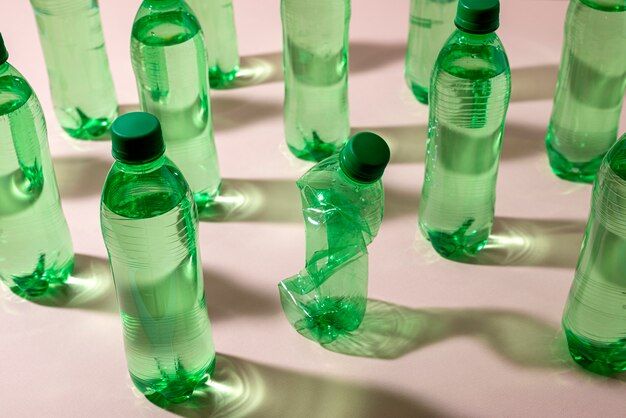
How Are Plastic Bottles Made? A Clear Article to See
Do you always wonder how are plastic bottles made? Isn't plastic poison sometimes? Actually, the bottles we use to drink are made of PET plastic, which is bottled grade PET material, it has various advantages to our life, and it's recyclable. In this article, you will understand the production, and recycling processes, and the myriad uses of recycled PET resin unveil the significant impact and potential of this material in reducing environmental harm.
What is the Best Plastic for Water Bottles?
Polyethylene Terephthalate (PET) plastic is the best plastic for water bottle production. This means that this is safe and healthy to be used as a drinking water bottle. These are also usually BPA-free plastic water bottles. In our daily lives there are a lot of plastic bottles made of PET plastic, such as soda bottles, bakery products, water bottles, peanut butter jars and even frozen foods packaging.
Why Do We Use PET Plastic?
PET plastic is better than normal plastic when producing bottles, it has various of unique properties which have ensured PET is rapidly becoming the world's favorite packaging material, particularly for food and beverages.
PET plastic bottles have many advantages not only for the products being stored but also for the consumer and the environment. Some of these advantages include:
Energy Efficiency: PET packaging requires less energy and resources during manufacturing compared to glass, conserving fossil fuels and water.
Recyclability: PET plastic bottles are 100% recyclable. Modern advancements have reduced their weight by 30%, minimizing plastic usage.
Chemical Resistance: PET creates a strong barrier against external elements, ensuring the safety of consumable goods by preventing reactions with water or food.
Durability: Unlike glass, PET plastic is shatterproof, making it safer for transportation and reducing breakage risks.
Flexibility in Design: Its ability to be molded into various shapes at a lower cost than glass allows brands to create distinct packaging designs, helping products stand out on store shelves."
how to produce plastic bottles
"The production of plastic bottles involves several stages:
Deriving from Fossil Fuels: Most plastics originate from oil or natural gas containing hydrocarbons.
Monomer Formation: Subjecting hydrocarbons to high temperatures breaks them down into smaller units known as monomers.
Polymer Formation: Monomers are linked together through polymerization or polycondensation processes to form polymers, creating different types of plastic based on the combination of monomers.
Manufacturing Plastic Bottles: The resulting plastic, in pellet, powder, flake, or liquid form, serves as the basis for making plastic bottles.
Recycling Integration: Plastic pellets, often combined with recycled ones, are heated to high temperatures, turned into a liquid, and injected into molds to shape into bottles.
How Are PET Bottles Recycled?
PET recycling involves two primary methods: mechanical and chemical. Mechanical recycling focuses on obtaining clean PET flakes used directly or in combination with virgin polymer for various end products. Chemical recycling involves depolymerizing PET, which demands careful consideration due to potential environmental impacts.
Mechanical recycling is the predominant method used for PET recycling. It involves acquiring clean PET flakes, which are either utilized directly or combined with fresh polymer in subsequent processes to create diverse end products. The purity level of the retrieved material holds immense significance within this procedure.
In Spain, this system is extensively employed to recover PET. Through this method, high-quality flakes are obtained, enabling the production of sheets, fibers, or strips. The distribution of rPET in the market for these categories stands at 65%, 30%, and 3%, respectively.
On the other hand, chemical recycling represents an alternative approach to reclaiming post-consumer waste. This method revolves around depolymerizing PET using chemical agents, potentially releasing harmful substances detrimental to the environment. Various processes are selected based on the material's quality and the demand for intermediate products:
Glycolysis: Involves dissolving PET in an excess of ethylene glycol at elevated temperatures to reverse the condensation reaction.
Methanolysis: Encompasses PET depolymerization by subjecting the polymer to substantial amounts of methanol alongside a catalyst under high pressure and temperature (180-280ºC).
Hydrolysis: This entails treating PET with water and acid to produce terephthalic acid (TA) and ethylene glycol. These byproducts require purification before reuse. Commercial hydrolysis is less prevalent compared to glycolysis and methanolysis due to its lower occurrence.
What Is Recycled PET Used For?
Recycled PET resin serves as a valuable resource for manufacturing, capable of being repeatedly reprocessed and reused in bottle production. Opting for recycling rather than landfill disposal and utilizing the reprocessed PET material as a raw ingredient for fresh products significantly diminishes the environmental impact of greenhouse gas and carbon emissions. Moreover, this approach demands less overall energy for the creation of new products.
Conclusion
We have known how are plastic bottles made, and the properties of PET plastic. With WKAI as a notable PET plastic supplier, the prominence of Polyethylene Terephthalate (PET) plastic emerges as the ideal material for water bottles due to its safety, recyclability, and versatility in various products. PET plastic offers a multitude of advantages, including energy efficiency, recyclability, chemical resistance, durability, and design flexibility. The production of plastic bottles involves stages from deriving materials from fossil fuels to recycling integration. PET recycling methods, both mechanical and chemical, underscore the importance of clean PET flakes and the potential environmental impacts of certain chemical processes. Recycled PET resin serves as a crucial resource, significantly reducing environmental harm by reprocessing and reusing materials for new products. Embracing recycled PET material not only minimizes greenhouse gas emissions but also demands less energy for manufacturing, marking a significant stride towards a more sustainable future. With WKAI's role as a PET plastic supplier, the broader adoption of PET plastic in various industries may further contribute to environmental conservation and reduce the ecological footprint associated with plastic consumption.

